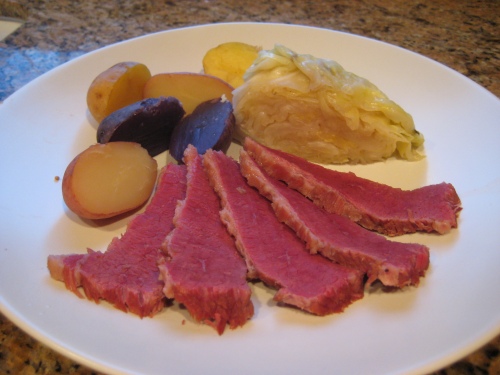How To Make The Best Corned Beef
Corned Beef and Cabbage: could there be a more quintessential Irish dish? Yes, there are many more authentic Irish foods because corned beef and cabbage was a meal created out of necessity and convenience by broke-ass American immigrants. I do love corned beef and cabbage and see it as the perfect culinary intersection of my Jewish-American and Irish-American heritages.
Corned beef, as we know it today, is a salt-brined beef brisket that is boiled or steamed. The “corn” refers to the large grain rock salt that was traditionally used in the brine. These days, due to the rise in popularity of barbeque, a decent brisket will run you $7-14 a pound, but back in the day the tough cut that has to be cooked for hours was considered poor-folk’s food. The corned beef brisket we enjoy each year on St. Patrick’s Day actually began as a Jewish butcher and deli staple. While the Irish did make salt-cured meat in the old country, they preferred to serve bacon with their cabbage. During the great period of American immigration at the turn of the last century, Irish and Eastern European Jewish immigrants settled close to each other in neighborhoods of major cities, like the Lower East Side in New York, and the birthplace of both my parents, the South Side of Chicago. The Irish immigrants found bacon in America was prohibitively expensive but discovered the corned beef from their Jewish neighbors a pretty damn good substitute.

Homemade corned beef and cabbage
As March 17th approaches you’ll find the grocery stores are piled high with shrink-wrapped pre-brined briskets with little spice packets included, some are even pre-cooked, but if you want to really impress your friends, brine your own brisket. Its fairly simple, it will cost less per pound, taste better and you can get multiple meals out of it. I like to make corned beef to serve with cabbage and potatoes on St. Patrick’s Day and then use the leftovers for reuben sandwiches. If I get really lucky and still have leftovers, I make corned beef hash for breakfast.
Like anyone with the smallest ounce of Irish blood, St. Patrick’s Day is the one day of year I fully embrace my Irish heritage. The Kushner side usually provides a lot more culinary inspiration, because lets face it, the Irish came over because they were starving as a result of subsiding solely on potatoes. But once a year I proudly give thanks to the O’Brien side for the ability to hold my liquor and appreciate a good whiskey. I get to thank both sides for the recessive gene that gave me my red hair, an unwavering talent for inflicting guilt, and corned beef and cabbage.
Here’s the recipe for you adventurous types:
If you want to make your own corned beef, it is incredibly simple but requires a 3-5 day head start. I recommend using sodium nitrate (pink salt) which will keep the corned beef pink and safely allow for the longer brine. If you are one of those anti-nitrate people and prefer to not use the pink salt, cut the brining time to 3 days to avoid bacteria formation and killing your guests. Also be prepared for a grey-ish color to the meat. Additionally you can replace the cabbage with brussel sprouts or add pretty much any root vegetable to the boil for a side dish.
Corned Beef and Cabbage
The Beef
- 1 5lb brisket
- 1 head of green cabbage, cut into sixths
- 1 lb potatoes
- 1 onion quartered
- 2 Tbs pickling spice
- 5 cloves of garlic smashed
The Brine
- 1 gallon of water
- 2 C kosher salt
- 1/2 cup sugar
- 1 oz (5 Tbs) pink salt
- 3 cloves of garlic minced
- 2 Tbs pickling spice
Mustard Sauce (mix ingredients together and refrigerate until ready to serve)
- 1 cup (8 ounces) sour cream
- 2 tablespoons prepared horseradish
- 2 tablespoons prepared mustard
- Combine all the brine ingredients in a large pot and bring to a simmer, stirring until the salt and sugar are fully dissolved. Remove the pot from the heat and allow to cool and then refrigerate until it is completely chilled.
- Place your brisket in a large (2+ gallon) zip top bag and place into a pan. Pour the brine into the bag and ensure the brisket is completed covered, removing as much air from the bag as you can. Place in the fridge for 5 days.
- Remove the brisket from the brine and brush off the spices. Place the brisket in the bottom of a large pot or dutch oven with the onion, garlic, potatoes and any root veggies. Add enough water to cover the the meat, mix in the pickling spices and bring to a boil. Reduce to a simmer and cover the pot cooking for about 3 hours (replenish the water if it gets low).
- Add the cabbage and cook for an additional 10 minutes. Remove the meat and vegetable and slice the meat against the grain.
- Serve warm with vegetables and sauce.
- Use the leftovers for Reubens the next day










